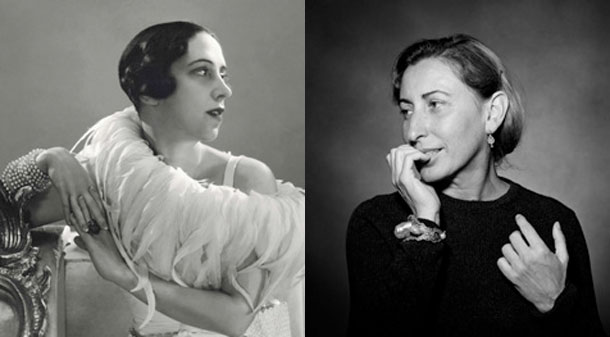 L – George Hoyningen-Huené (Russian, 1900–1968), Portrait of Elsa Schiaparelli, 1932. Hoyningen-Huené/Vogue/Condé Nast Archive. Copyright © Condé Nast. R – Guido Harari (Italian, born Cairo, 1952), Portrait of Miuccia Prada, 1999. Guido Harari/Contrasto/Redux.
L – George Hoyningen-Huené (Russian, 1900–1968), Portrait of Elsa Schiaparelli, 1932. Hoyningen-Huené/Vogue/Condé Nast Archive. Copyright © Condé Nast. R – Guido Harari (Italian, born Cairo, 1952), Portrait of Miuccia Prada, 1999. Guido Harari/Contrasto/Redux.
They have just released a preview of the Metropolitan Museum of Art’s upcoming exhibition, Schiaparelli and Prada: Impossible Conversations – and we like what we see. The exhibition points out similarities in the imaginative designers approach to fashion, focusing on seven specific themes. For each theme, a fictional conversation has been imagined and created by film director Baz Luhrmann. The exhibition will open with the fashion industry’s version of The Oscars – The Costume Institute Gala’s Met Ball – taking place on May 7th, 2012. Now, if we could just snag an invite to the Met Ball!
Follow the jump for a preview of the exhibit!
According to a press release from the Metropolitan Museum of Art, the exhibition will be categorized by seven main themes:
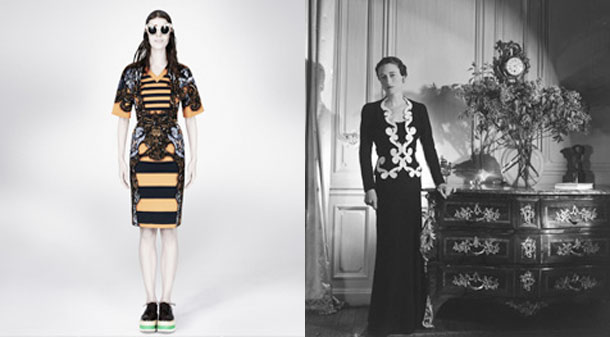 L – Miuccia Prada, spring/summer 2011, Photograph by © David Sims. R – Wallis Simpson in Elsa Schiaparelli, Vogue, June 1, 1937; Photograph by Cecil Beaton, Cecil Beaton Studio Archive at Sotheby’s.
L – Miuccia Prada, spring/summer 2011, Photograph by © David Sims. R – Wallis Simpson in Elsa Schiaparelli, Vogue, June 1, 1937; Photograph by Cecil Beaton, Cecil Beaton Studio Archive at Sotheby’s.
“Waist Up/Waist Down” will look at Schiaparelli’s use of decorative detailing as a response to restaurant dressing in the heyday of 1930s café society, while showing Prada’s below-the-waist focus as a symbolic expression of modernity and femininity. An accessories subsection of this gallery called “Neck Up/Knees Down” will showcase Schiaparelli’s hats and Prada’s footwear.
 L – Miuccia Prada, autumn/winter 1996–97; Photograph by © Toby McFarlan Pond. R – Elsa Schiaparelli, Vogue Paris, February 1927; Photograph by George Hoyningen-Huené. © R.J. Horst.
L – Miuccia Prada, autumn/winter 1996–97; Photograph by © Toby McFarlan Pond. R – Elsa Schiaparelli, Vogue Paris, February 1927; Photograph by George Hoyningen-Huené. © R.J. Horst.
“Ugly Chic” will reveal how both women subvert ideals of beauty and glamour by playing with good and bad taste through color, prints, and textiles.
“Hard Chic” will explore the influence of uniforms and menswear to promote a minimal aesthetic that is intended to both deny and enhance femininity.
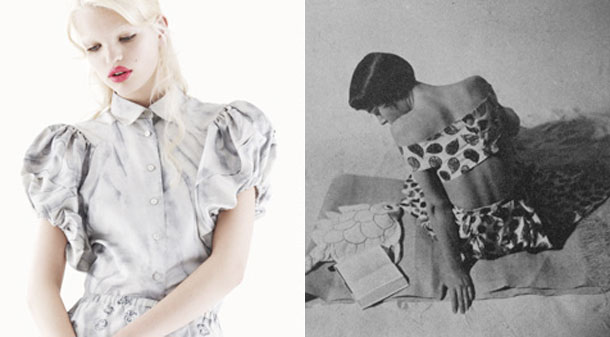 L – Miuccia Prada, spring/summer 2006; Photograph by © Toby McFarlan Pond. R – Elsa Schiaparelli, Vogue Paris, June 1949; Photograph by Rutledge. Rutledge @ Vogue Paris.
L – Miuccia Prada, spring/summer 2006; Photograph by © Toby McFarlan Pond. R – Elsa Schiaparelli, Vogue Paris, June 1949; Photograph by Rutledge. Rutledge @ Vogue Paris.
“Naïf Chic” will focus on Schiaparelli and Prada’s adoption of a girlish sensibility to subvert expectations of age-appropriate dressing.
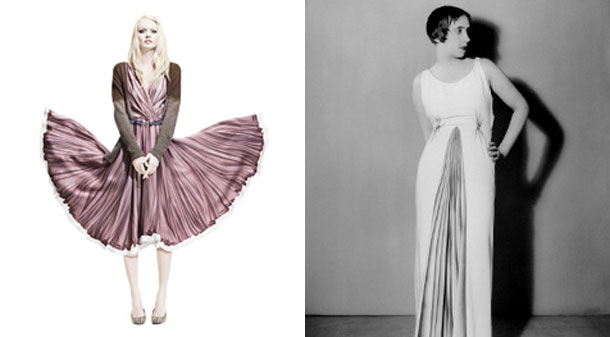 L – Miuccia Prada, autumn/winter 2004–5; Photograph by © Toby McFarlan Pond. R – Elsa Schiaparelli in Elsa Schiaparelli, autumn 1931; Photograph by Man Ray.© 2012 Artists Rights Society (ARS), New York / ADAGP, Paris.
L – Miuccia Prada, autumn/winter 2004–5; Photograph by © Toby McFarlan Pond. R – Elsa Schiaparelli in Elsa Schiaparelli, autumn 1931; Photograph by Man Ray.© 2012 Artists Rights Society (ARS), New York / ADAGP, Paris.
“The Classical Body,” which also incorporates “The Pagan Body,” explores the designers’ engagement with antiquity through the gaze of the late eighteenth and early nineteenth centuries.
 L – Miuccia Prada, spring/summer 2004; Photograph by © Toby McFarlan Pond. R – Elsa Schiaparelli, Vogue, June 1, 1935; Photograph by Horst. Horst / Vogue; © Condé Nast.
L – Miuccia Prada, spring/summer 2004; Photograph by © Toby McFarlan Pond. R – Elsa Schiaparelli, Vogue, June 1, 1935; Photograph by Horst. Horst / Vogue; © Condé Nast.
“The Exotic Body” will explore the influence of Eastern cultures through fabrics such as lamé, and silhouettes such as saris and sarongs.
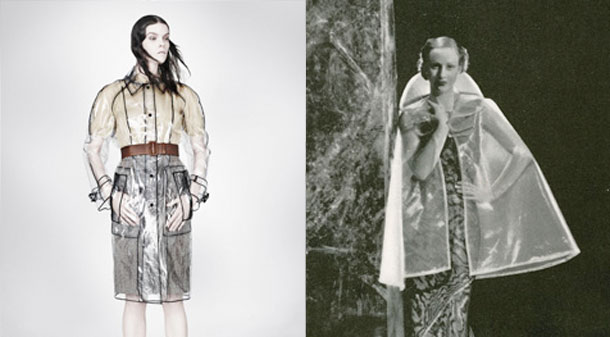 L – Miuccia Prada, autumn/winter 2002–3; Photograph by © David Sims. Elsa Schiaparelli, Harper’s Bazaar, February 1935; Photograph by André Durst Harper’s Bazaar/Hearst Communications, Inc
L – Miuccia Prada, autumn/winter 2002–3; Photograph by © David Sims. Elsa Schiaparelli, Harper’s Bazaar, February 1935; Photograph by André Durst Harper’s Bazaar/Hearst Communications, Inc
“The Surreal Body” in the final gallery will illustrate how both women affect contemporary images of the female body through Surrealistic practices such as displacement, playing with scale, and blurring the boundaries between reality and illusion as well as the natural and the artificial.
All Photos Courtesy of the Metropolitan Museum of Art.
Source: The Cut


